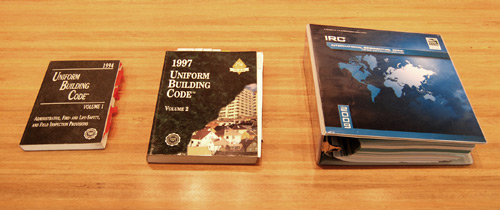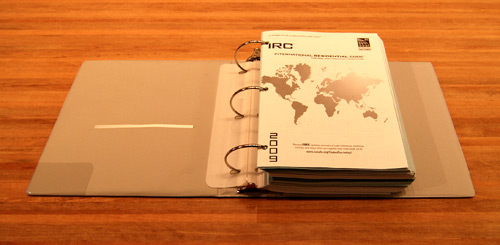
Like most jurisdictions, the City of Seattle recently adopted the 2009 International Residential Code. For you non-architects out there, this is the book that guides most everything about what can and cannot be done with the design of a home; it is what jurisdictions look to for enforcement; it is the rule book for architects.

We recently bought our office copy ($98.10) and we’ve had a chance to get familiar with it. And maybe it’s just us, but it seems like this thing is getting a bit out of hand. The IRC is 868 pages plus the City of Seattle amendments which add about another 250 pages to the volume. For conversation sake, lets round it off to a clean 1,100 pages. ELEVEN HUNDRED mind-numbing pages, it’s like 1.5 copies of the Fountainhead, except without the plot twists and the dry protagonist to keep you entertained. It doesn’t even have a bad guy! We digress… where were we. Ah yes, eleven hundred pages; is a document this extensive really necessary for the design of a house?

Keep in mind, this is just the building code, in addition to this code there is the structural code ($79.99), the fire code ($79.99) the electrical code ($119.00) and the mechanical code($61.00). To say nothing about Municipal Codes which govern land use and the ICC/ANSI which governs accessible design. When stacked on top of one another, all the code books required for the design of a home comprise the 2nd tallest structure in the world.

Don’t get us wrong, we like doing our homework and being diligent. It’s part of an architect’s job to be familiar with the current code, to follow the rules, and to design safe buildings. It just seems that the International Residential Code has gone way beyond the mission of “developing better building construction and greater safety to the public by uniformity in building law”. It’s practically turned into hyperbole. Just 15 years ago the building code was a manageable little book, but with each new release it becomes larger and more unmanageable. None of the building code’s friends have the gumption to say it to his face, but the building code has a weight problem.

Since we’re going to be dealing with this gargantuan volume for the next several years, it’s bound to generate a great deal of frustration. We figured we’d get this off our chest now, that way in our future blog rants we’ll have something to refer back to. Here are our top 5 criticisms of the 2009 International Residential Code:
1. This thing is enormous –it used to be that you could put the code in your bag, take it to a job site, take it to the meeting with your structural engineer. The current code basically requires its own table in the office. Taking this thing to a job site would require a trailer. Note to the International Code Council; when the volume gets bigger than the houses it governs, it’s time to scale back.
2. It is complicated and nebulous -this thing is so complicated that they actually sell a Guide to Understanding the 2009 International Residential Code ($39.99). We’re no experts in the publishing world, but typically when a book needs a second book to explain the first book, the first book shouldn’t get published in the first place. No?
3. It’s not actually standardizing much -the IRC intends to standardize building codes from one county or city to another, but cities continue to develop ever more complicated addendums of their own, thereby contradicting the standardization. The city of Seattle addendum is 1/3rd the size of the building code. Really, city of Seattle? You had a conflict with a third of the codes? At this point it might be simpler if cities just came out with their own building codes and gave up the illusion of being standardized.
4. It is making design and construction more expensive –even researching a simple detail (like a handrail) in these codes can consume an unproportional amount of time. It takes more time in design and it takes more time for the city to review and approve permits. All of this drives up the cost to the homeowner.
5. It reinforces loopholes –with each iteration, the building code acts less as a guide and more as an exact prescription of how things are designed and constructed. The constricting nature of the building code leaves less room for interpretation and less opportunity to meet the requirements though innovative design. The creativity that architects are becoming good at is, rather, finding loopholes and exceptions in the code that allow for good design.
Ahh, that feels much better. So that’s our two cents, what’s yours?






